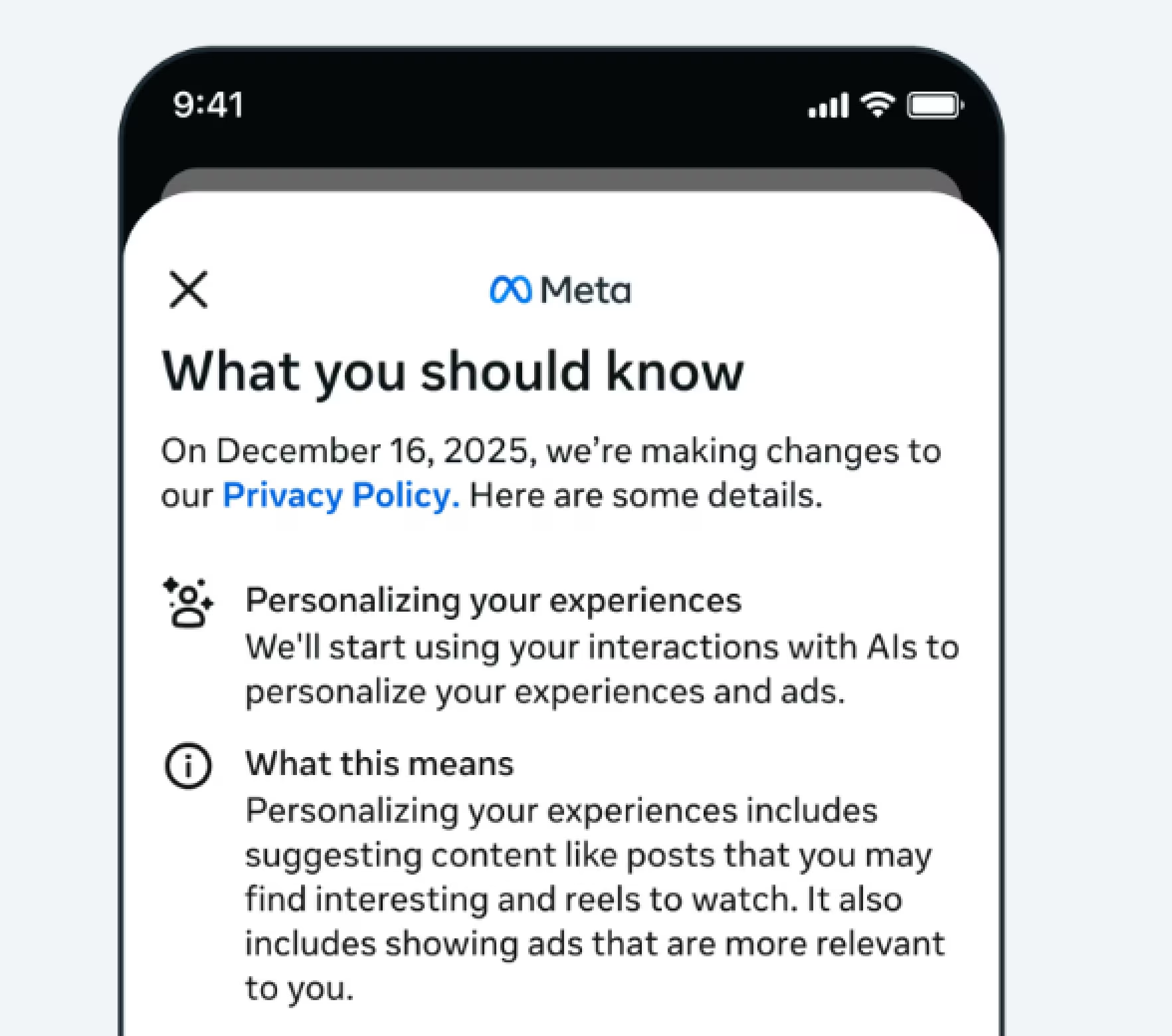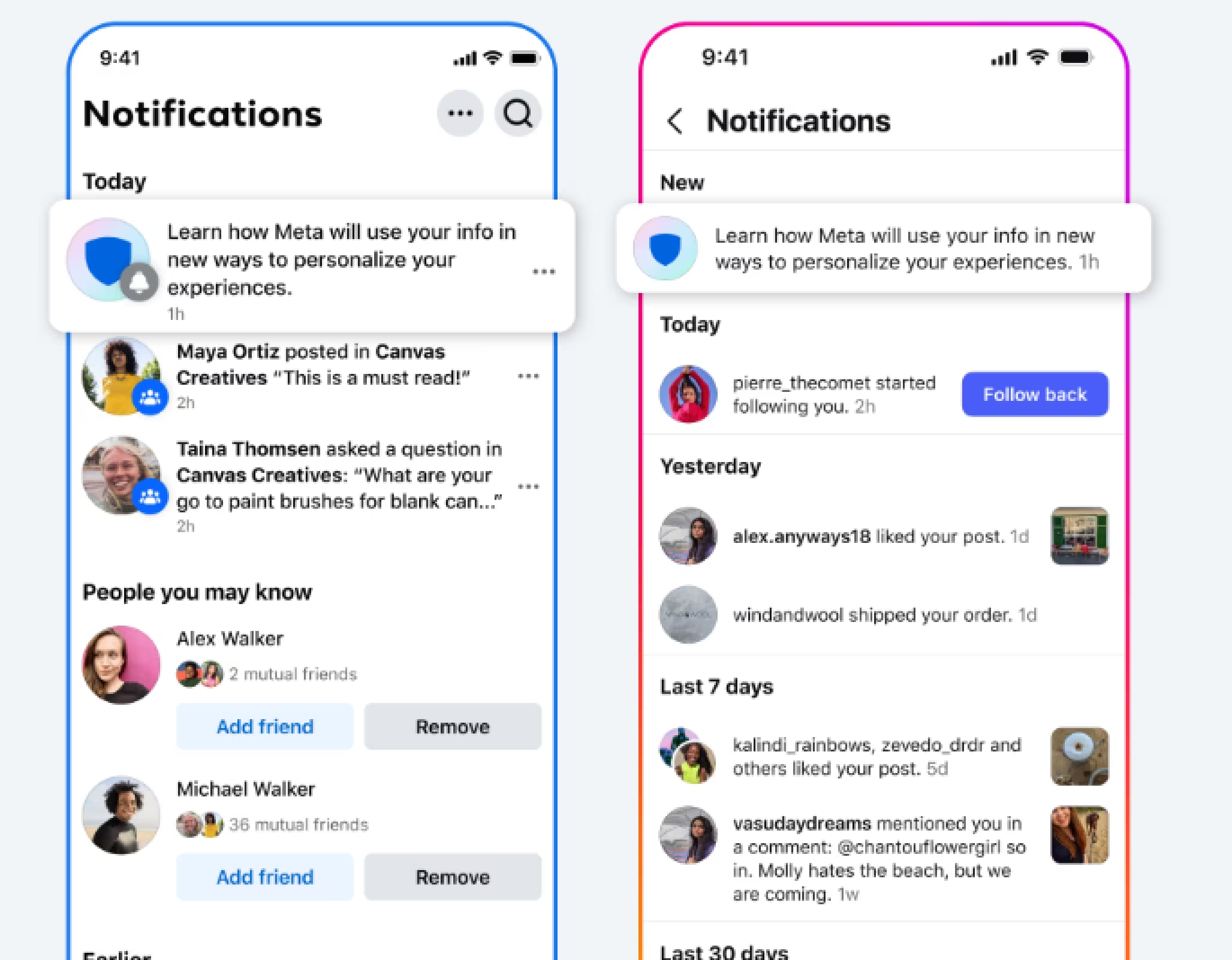Starting December 16, 2025, Meta will use conversations users have with Meta AI to personalize ads across Facebook, Instagram, WhatsApp, and Messenger. This affects 1 billion monthly Meta AI users and marks Meta's most direct move yet to monetize its AI investments. There's no opt-out option, so if you use Meta AI, your conversations become targeting signals. Marketers gain unprecedented insight into user intent, but face new privacy concerns.
What's Actually Changing
Meta announced on October 1, 2025 that user interactions with Meta AI, their chatbot across Facebook, Instagram, Messenger, WhatsApp, and Ray-Ban smart glasses, will become part of their ad targeting system.
If a user asks Meta AI "What hiking boots are good for beginners?" they'll start seeing ads for hiking gear, recommendations for hiking groups, and posts about trails. Previous targeting relied on what users chose to share publicly. AI conversations feel private, even when they're not.
The Timeline
- October 7, 2025: Users started receiving notifications
- December 16, 2025: Policy goes into effect
- Initial exclusions: UK, South Korea, and European Union
- Past conversations: Anything before December 16 won't be used
What Gets Used (and What Doesn't)
Meta will use both text and voice conversations. If you're wearing Ray-Ban Meta glasses and ask a voice question, that data feeds the targeting system.
Conversations about these topics won't be used for ad targeting:
- Religious views
- Sexual orientation
- Political views
- Health conditions
- Racial or ethnic origin
- Philosophical beliefs
- Trade union membership
Traditional vs AI Conversation Targeting: What's Changed
The 4 Biggest Impacts on Your Ad Strategy
1. Intent Data Just Got More Explicit
Meta's traditional targeting relied on signals: you liked a travel page, so you might want vacation ads. Now they have direct intent: "I'm planning a family trip to Orlando in March."
- For freelance marketers: Your clients running local services get access to people actively researching solutions. If someone asks Meta AI "best coffee shops near me," local businesses can reach them at decision time.
- For small business owners: Someone asking about "affordable bookkeeping software" is in-market. The AI conversations reveal purchase intent that previously required expensive third-party data.
- For agencies: Prepare client briefs around conversational intent. Someone asking "how do I remove pet stains from carpet" is further down the funnel than someone who just follows a pet care page.
2. Your Manual Audience Building Matters Less
A real example: You run ads for a yoga studio. Someone never liked a yoga page, never posted about fitness, never engaged with wellness content. But they asked Meta AI "yoga studios with childcare near downtown Seattle."
Under the old system, they're invisible to you. Under the new system, they're a perfect match.
Meta's AI will find your customers based on what they explicitly say they want, not just passive signals.
3. Privacy Concerns Will Affect User Behavior
Emily Bender, linguistics professor at the University of Washington, told Fortune this is "surveillance under the guise of personalization." She warns that financial incentives may push Meta to design chatbots that extract more targetable information.
What this means: User trust directly impacts ad performance. If people start avoiding Meta AI or deliberately giving false information, targeting quality degrades. Some privacy-conscious users may prefix queries with "For religious reasons, I'm wondering..." to trigger sensitive topic filters.
Monitor whether your Meta AI-influenced audiences convert differently from traditional audiences.
4. The Chatbot Becomes Your Competitor
Meta doesn't show ads inside AI conversations (yet). But the chatbot can answer product questions and provide recommendations (OpenAI launched direct ChatGPT shopping in October 2025).
Say you sell running shoes. Someone asks Meta AI "what running shoes should I buy for flat feet?" The AI provides general advice. Then they see your ad. But they already got an answer.
Your ad needs to offer something beyond the free chatbot: a limited-time discount, free gait analysis, or social proof from real runners.
Meta's Bigger AI Ad Plan: Full Automation by 2026
This targeting change is one piece of a larger strategy. According to The Wall Street Journal, Meta aims to enable fully automated AI-generated ads by 2026.
The vision: You input your business URL and budget. Meta's AI creates the ad creative (images, video, text), selects audiences, decides Facebook vs Instagram, and optimizes spend, all without your input.
Mark Zuckerberg described it: "You tell us what your objective is, you connect to your bank account, you don't need any creative, you don't need any targeting demographic."
This makes sense given 98% of Meta's $196 billion in annual revenue comes from advertising. They earned $46.5 billion in ad revenue last quarter alone, up 21% year-over-year. With AI infrastructure costs projected to reach $600 billion over the coming years, Meta needs to extract more value from their ad platform.
AI conversation targeting feeds that system. The chatbot data trains automated ad creation. If Meta knows a user asked about hiking, the AI can automatically generate personalized hiking boot ads.
The takeaway: AI conversations aren't just about better targeting today. They're building the foundation for a future where you might not control your creative, audience, or placement decisions.

5 Things You Should Do Before December 16
1. Document Your Baseline Performance
Track these metrics separately through December 15:
- Cost per click
- Conversion rate
- Cost per acquisition
- Click-through rate by placement
After December 16, look for sudden improvements in engagement or conversion from audiences you didn't target. That's Meta's AI finding new users through conversation data.
You can export this data manually from Meta Ads Manager, or automate it with tools like Dataslayer if you're tracking multiple campaigns or combining Meta data with other marketing platforms.
2. Test AI-Aware Creative Now
Your creative can acknowledge that users are actively researching. Instead of "Shop our collection," try "Comparing options? Here's what makes us different."
Example: You run Facebook ads for a bookkeeping service. Your generic ad says "Affordable bookkeeping for small businesses." Your AI-aware ad says "Already know you need bookkeeping help? Start your free trial today."
The second version speaks to someone who just asked Meta AI about bookkeeping solutions.
3. Start Testing Advantage+ Campaigns
Even if you're not ready to hand over creative control, experiment with Advantage+ now. Learn what Meta's algorithms prioritize with more autonomy. This prepares you for potential full automation.
4. Prepare Your Client Communication
If you're an agency or freelancer, get ahead of client questions:
"Meta's using AI conversation data starting December 16. This means your ads might reach people who've explicitly asked about products like yours. We'll monitor performance and adjust if targeting quality changes. Here's what we're testing..."
5. Monitor EU Audience Impact
Meta isn't rolling this out in the EU, UK, or South Korea. If your audience skews privacy-conscious (tech workers, journalists, activists), they might reduce Meta AI usage. Watch for reach or engagement drops among specific segments.
Real-World Examples: How This Changes Marketing
Example 1: The Freelance Web Designer
Maria runs Facebook ads for her web design services targeting small business owners in Denver. Current audience: business page admins in Denver, aged 35-55, interested in entrepreneurship.
After December 16, someone asks Meta AI: "How much does it cost to build a website for a small bakery?" Even if they never engaged with business content, they're now a qualified lead. Maria's ads appear exactly when they're evaluating options.
Maria adjusts her creative: "Comparing web designers? See our transparent pricing and 30-day launch guarantee."
Example 2: The E-commerce Store Owner
James sells eco-friendly camping gear through Shopify. He runs standard product catalog ads with Advantage+ Shopping campaigns.
When someone asks Meta AI "camping gear that's actually sustainable," Meta has explicit confirmation of purchase intent and values alignment. James doesn't change his targeting, Meta's AI automatically expands his audience.
James notices his cost per purchase drops 15% in January 2026, driven by new customers who never previously engaged with outdoor content.
Example 3: The Digital Marketing Agency
An agency manages Facebook ads for 30 clients. They create a new service tier: "AI Conversation Optimization."
For each client, they audit customer research patterns, what questions do people ask before buying? They craft content encouraging Meta AI engagement. When people ask those questions, client ads appear in context.
They run tests: Do AI-qualified audiences have higher lifetime value? Lower return rates? Better reviews? This data justifies premium pricing.
The 3 Difficult Questions We Can't Answer Yet
1. Will People Trust AI-Influenced Ads?
If users discover their private questions about debt consolidation led to predatory loan ads, trust evaporates. We don't know if targeting improvements come at the cost of platform trust.
2. Who Benefits Most: Big Brands or Small Businesses?
Meta says this democratizes access. But larger advertisers with resources to test AI-optimized campaigns might capture most benefits. A freelancer running ads for three local clients can't A/B test dozens of variants like a global agency managing $10 million monthly spend can.
3. What Happens to Ad Costs?
Better targeting usually means higher costs per impression but better conversion rates. The net effect on cost per acquisition? Too early to tell. Niche products (vegan leather hiking boots) might see dramatic efficiency gains. Saturated categories (online courses) might not move much.

FAQ
Q: Can I opt out of Meta using my AI conversations for ad targeting?
No. The only way to prevent your conversations from influencing ads is to not use Meta AI. You can adjust which ads you see using Meta's Ad Preferences tool, but you can't prevent conversation data collection.
Q: Will my conversations from before December 16, 2025 be used?
No. Meta explicitly stated only conversations after the December 16 launch date will be used. Previous conversations are excluded.
Q: Does this apply to WhatsApp conversations?
Only if you've linked your WhatsApp to your Meta Accounts Center. If your WhatsApp is separate from Facebook/Instagram, those AI conversations won't personalize ads on other platforms.
Q: How do I know if someone reached my ad through AI conversation data?
You can't identify these users in Meta Ads Manager. The conversation data gets incorporated into Meta's overall algorithm, but isn't broken out separately. Track overall performance changes after December 16 and infer impact from unexpected audience expansion or improved conversions.
Q: What if I advertise health or political products?
You can still run those ads using traditional signals (likes, follows, engagement). Meta just won't use AI conversations about those topics for targeting. If someone asks Meta AI "how do I treat insomnia," you can't target them based on that conversation, but you can still target people who follow sleep wellness pages.
Q: What if my audience is mainly in Europe?
This feature isn't rolling out in the EU, UK, or South Korea initially. If your target market is primarily there, this change won't affect your campaigns. Continue with your existing strategy.
Conclusion
Meta's AI conversation targeting represents the most direct line yet between user intent and ad delivery. For marketers, this creates both opportunity and uncertainty.
The opportunity: Reaching people when they're actively researching solutions, not passively scrolling.
The uncertainty: Less control over targeting, more reliance on Meta's AI to find customers, and open questions about privacy backlash.
Start testing now. Document your baseline performance. Prepare clients for changes. And watch how this unfolds over the next six months, because if this works as well as Meta hopes, it's not just changing how we target Meta AI ads. It's changing the entire relationship between conversation, intent, and commerce.
Need to track Meta performance changes? If you're comparing pre- and post-December 16 results across multiple campaigns or combining Meta data with Google Ads, GA4, or other platforms, Dataslayer automates the data pulling into Google Sheets, Looker Studio, BigQuery, or Power BI. Try it free for 15 days to see if automation saves you time during this transition period.







